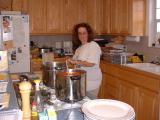
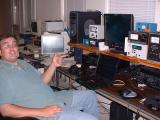
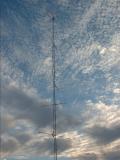
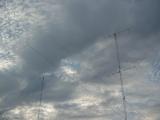
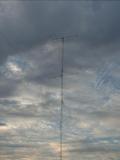
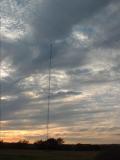
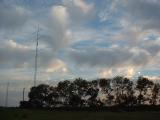
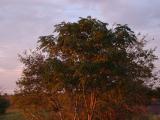
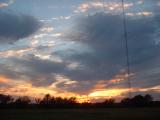
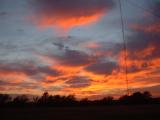
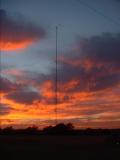
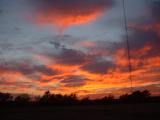
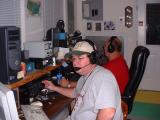
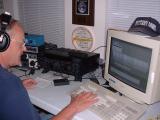
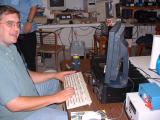
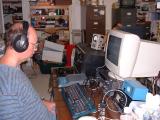
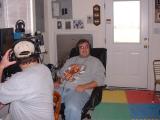
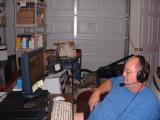
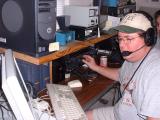
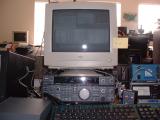
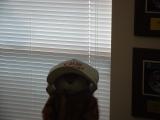
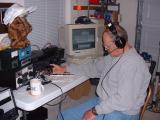
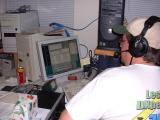
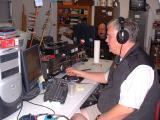
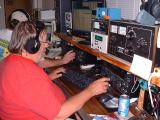
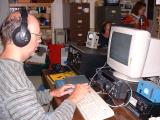
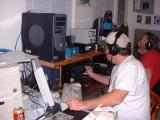
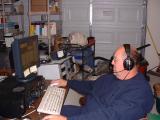
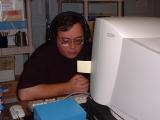
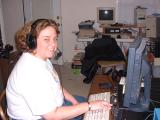
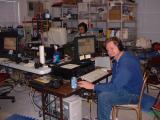
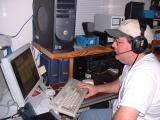
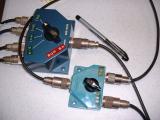
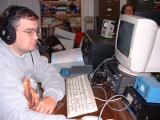
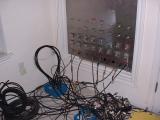
I got to join the team at K5NA for a multi-operator, multi-transmitter contest effort in the 2003 CQ World Wide DX Contest, Phone. This is the first time I've operated in a multi-multi and the first time K5NA has done a multi-multi from his station in Texas. We had six radios, six amplifiers, and eleven operators.
These photos are copyright © 2003 Kenneth E. Harker. All rights reserved.
 |
Susan King K5DU was in charge of logistics and meals all weekend. An hour before the start of the contest, the team enjoyed a meal of spaghetti and meat sauce. Susan also operated on 160 meters. |
 |
Scott Pederson KI5DR wrestled with the computer networking situation up until the very last minute before the start. The collection of logging computers brought to the station for the weekend included machines with Windows 98, Windows 2000 Pro, Windows XP Home, and Windows XP Pro. Eventually, all of the computers were networked using Writelog for Windows except the 40 meter computer (the Windows XP Home system.) |
 |
This is the 15 meter tower at K5NA. The antennas are Cushcraft XM515 five-element monobanders, except the second-lowest antenna, which is a Cushcraft XM510 five-element monobander for 10 meters, which was installed on the Tuesday before the contest. |
 |
The tower on the left is the 40 meter tower, with a stack of Cushcraft XM240 two-element monobanders, and the tower on the right is the 20 meter tower, with a stack of Cushcraft XM520 five-element monobanders. |
 |
A view of the top of the 20 meter tower. Just below the frame is a Cushcraft XM510 five-element monobander for 10 meters that was installed on Tuesday before the contest. |
 |
A view of the 40 meter tower, with three Cushcraft XM240 two-element monobanders. |
 |
The "Heard Island Tower" in front of a row of wind-break trees. So-called because it was installed just in time to work the 1997 VK0IR DXpedition to Heard Island, the tower now has a Cushcraft XM240 two-element monobander for 40 meters and a Cushcraft X9 tribander for 20 meters, 15 meters, and 10 meters. The tribander was used exclusively on 10 meters for the contest. The large freestanding tower in the distance is a Sprint PCS tower. |
 |
One of the trees near the back porch of the house, about half an hour before the start of the contest. |
 |
There was a gorgeous sunset Friday night just before the contest. |
 |
The house is to the ENE of most of the antennas, on the northern edge of the property. The line of trees marks the southern edge of the property. |
 |
The middle yagi on this tower is fixed at 45 degrees, and the top one rotates. The top antenna was probably at about 60 degrees when this photo was taken around 2345 UTC Friday night. |
 |
This is looking in the direction of downtown Austin, about a half-hour drive away. From the top of the 40 meter tower, one can easily see the downtown area. |
 |
Friday night, around 0330 UTC. Reid Hill KC5YKX is operating on 15 meters. He traveled all the way from Corpus Christi (about a four-hour drive away) to operate at K5NA. Behind him, Marty Fitzgerald W5MF is operating on 40 meters. Marty drove in from the Houston area, about three hours away. |
 |
George Miller K2UR, operating 80 meters. George came down to Texas from New Jersey a week before the contest to help install antennas and prepare the station for the contest. He planned to stay for a week after the contest to go fishing. |
 |
Scott Pederson KI5DR, operating at the 20 meter station. Scott did tremendous work getting the computers and logging software going before the contest. |
 |
Damon Ginbey N5GM started the contest on 10 meters. The 10 meter station used an actual Nel-Tech DVK-100 digital voice keyer (to the left of the keyboard,) still operational after over 20 years! |
 |
Saturday morning, with Reid Hill KC5YKX on 15 meters and Scott Pederson KI5DR on 40 meters. The colorful interlocking children's foam play mats on the floor covered coaxial and other cables, so that we could walk around and not worry about tripping on or damaging the cables. |
 |
Marty Fitzgerald W5MF, operating 20 meters, around 1430 UTC Saturday. |
 |
Reid Hill KC5YKX on 15 meters. The 15 meter and 40 meter radios were at the operating desk Richard and Susan use for DXing and single-operator contesting. This meant that the 15 meter radio was off to the side of the keyboard and monitor. The other stations were better laid out. The 80, 40, 20, and 15 meter stations all used Yaesu FT-1000 MP Mark V transceivers. |
 |
The 10 meter station used a Kenwood TS-850SAT and a borrowed Ameritron AL-1200 amplifier. The WX0B StackMaster on the right let the operator switch between three fixed yagis and the rotatable tribander. The little box with the red buttons was a home-made remote for the Nel-Tech DVK-100 digital voice keyer (the gray box to the left of the keyboard.) The buttons on the remote were a lot easier to press than the chiclet-style buttons on the Nel-Tech box itself. |
 |
At some point on Saturday, Susan brought out this novelty dancing hamster. |
 |
Sunday morning, around 1130 UTC, George Miller K2UR is tuning 80 meters looking for new stations before sunrise. Notice the look of deep concentration. |
 |
Reid Hill KC5YKX on 15 meters, waiting for Sunday sunrise. |
 |
Dana Roode K6NR, tuning for stations on 160 meters before sunrise. Dana came all the way from southern California to operate the contest at K5NA. The 160 meter radio was an Icom IC-765. |
 |
Richard King K5NA, operating on 40 meters at sunrise. By this point in the contest, we had over 100 countries worked on 40 meters. |
 |
Damon Ginbey N5GM, working the weak stations on 10 meters Sunday morning. |
 |
Reid Hill KC5YKX on 15 meters around 1300 UTC Sunday. |
 |
Marty Fitzgerald W5MF, on 20 meters Sunday morning. |
 |
Ken Harker WM5R, calling CQ on 10 meters Sunday morning. |
 |
Jen Harker W5JEN, operating 20 meters around 1830 UTC Sunday. |
 |
You can see four of the six stations in this view. Robert Brandon K5PI is operating on 20 meters, and behind him Scott Pederson KI5DR is operating on 10 meters. To the left of Robert is the 160 meter position, and in the far left of the frame, to Scott's right, is the 80 meter operating position. The 40 meter and 15 meter operating positions are to the left of this photo. This was around 1945 UTC Sunday. |
 |
Reid Hill KC5YKX, operating through the big solar flare conditions Sunday afternoon on 15 meters. |
 |
The switching setup for the 160 meter station. The switch on the bottom let the operator choose to listen on the transmit antenna or one of the beverages, and the switch above selected which beverage. The radio would always transmit on the transmit antenna. |
 |
Scott Pederson KI5DR on 10 meters around 2000 UTC Sunday. The head poking above the monitor is Robert Brandon K5PI on 20 meters. |
 |
The entire station was off the air for about 45 minutes Sunday afternoon as a brief thunderstorm rolled through. It took a full ten minutes just to re-connect all the cables when we got back on the air. |
|
Last Updated 26 June 2020 wm5r@wm5r.org |